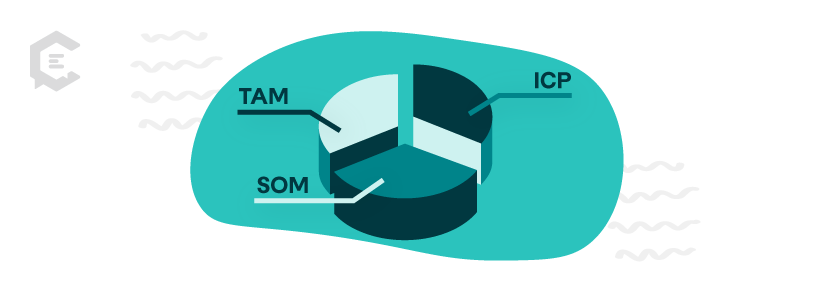What is market segmentation? Market segmentation is a process in which prospective buyers are grouped together based on their similar needs, habits, demographics, or behavior. These groups generally respond similarly to calls to action and marketing approaches.
It’s always frustrating when people with access to a new app or social media network declare themselves marketers when they’re simply plugging in information and hoping for the best. As we all know, there’s an art to marketing well.
Along with the nuanced views of planning and executing a strategy is understanding how each approach or technique might work best. Case in point, market segmentation. Whether you’re selling stocks or gym socks, finding a way to clearly market your product to your finely tuned demographic means not only won’t they tune out your approach, but they might actually keep an eye out for it.
Understanding market segmentation
Before we dig any deeper into the topic, Megan Pratt, principal product manager for AdRoll, said that “Market segmentation means grouping customers based on certain characteristics. This could mean anything from purchasing habits, demographics, or socioeconomic status. These groupings help marketers craft more effective messaging, making campaigns more personal, and hopefully, more effective.”
Why the personalized approach works
To expand a bit on the above explanation, market segmentation works by identifying the likes or buying habits of a specific demographic and then targeting them with more of what you already know they like.
“We’re living in a world where third-party data is on its way out,” said Pratt. “Things like cookies can only do so much, and a lot of people are not opting in for them anymore. They are over-saturated with ads. They’re tired of generalized messaging. We can’t keep doing the same trick over and over again, hoping that it will keep working. The way to catch your customer’s eye is to give them something that really speaks to them.”
And what might really speak to them is an ad or incentive that highlights exactly what they might not have even known they were looking for. Or as Pratt puts it, “Market segmentation helps you take key factors into account when you’re creating messaging and more effectively speak to that specific subset of your audience. It is the natural next step in creating campaigns that work.”
Unexpected benefits of market segmentation
Let’s face it, creating a personalized approach takes a lot more time than just creating a single ad or campaign and hoping for the best. But spending that extra time studying your target demographic also produces a lot more benefits as well.
“With market segmentation, you can get a better understanding of how each group responds to messaging,” said Kimberley Ring Allen, professor of marketing at Suffolk University.
Ring Allen, who focuses on topics including principles of marketing, digital marketing, and consumer behavior, explained that, as you understand your audience better, you might realize that it’s wiser to focus on price versus value.
Or in studying your audience’s digital habits, you might also find “what channels are the most effective in reaching that audience and what retail channels are the best to distribute through.”
Sharing more targeted information to protect your privacy
Not too long ago, Google made what seemed like a shocking announcement saying they were ending cookie usage by 2024. In an effort to curb personal data being more invasive than helpful, the new approach is a variation of market segmentation.
Using something called Federated Learning of Cohorts (FLoC), the new program will attempt to replace third-party cookies by placing users into groups based on common interest.
Best yet, the program comes with a built-in learning curve so that both marketers and consumers can try the new approach on for size before fully committing.
3 key market segmentation terms to keep in mind (and how to use them)
If you like to get technical or prefer to take a deeper dive into relevant marketing speak, Jen Anderson, vice president of marketing for Overhaul, a software-based supply chain integrity solution, shared three key terms to keep in mind for success in market segmentation:
1. TAM: Total Addressable Market
Anderson describes this as “The universe of everyone who could potentially buy your product.” Many savvy marketers will analyze their approach to come up with primary, secondary, or tertiary markets (or beyond). While overall messaging could potentially stay the same, some key points vary depending on everything from location to finances to age group.
2. SOM: Serviceable and Obtainable Market
Once you’ve figured out who you’re targeting, it’s time to determine the portion of your TAM that you can realistically obtain. That could mean without overspending on customer acquisition or simply understanding who might buy on a whim or who might need a sweeter deal.
3. ICP: Ideal Customer Profile
Here’s the part where you take an even deeper dive into market segmentation. Anderson describes the ICP as “The portion of your SOM that is MOST likely to buy your product or service if they become aware of what you do and the value behind it.”
The idea isn’t to sway your targeted demographic but almost to romance them, so they feel seduced by your product or service and fully understand the value you bring to their life.
Anderson said that “focusing on your ICP allows you to focus on the segment of the market where you’ll see the highest return on your marketing investment (ROMI) with the highest margins because of higher LTV (customer lifetime value). Better fit = less churn = higher profit per customer over time.”
What that means for you in terms of your marketing is that you’re not wasting valuable resources or investing in campaigns that are hit or miss. By analyzing and targeting, you are already guaranteed a better chance that your efforts will translate to engagement or sales, depending on your goals and ultimate measures of success.
Anderson said that “during the product-development process, you should be building for an ICP. As it’s part of the product lifecycle, this shouldn’t come after the fact. When you identify a customer that has an unmet need, you quantify the value of meeting that need, you calculate the cost of building to meet that need and, if it’s profitable, it’s worth pursuing.”
And how do you measure if you’ve succeeded? Anderson said, “You’ll know you have a strong product-market fit when you have a clear message that resonates with a specific group of people who then buy your product when exposed to it.”
Ways you might segment your market
To begin with, Pratt said, “Any data point you have about your customer is helpful here.” So before you despair and think that you know nothing about your customers, take another look at what they’ve shared.
No matter where you start, you’re already on the path to fine-tuning your approach.
And because consumers’ interests vary so greatly, there are almost endless categories you can place your desired customers into.
15 sample segments:
- Age
- Household income
- Gender
- Political party
- Past purchasing habits
- Geographic location
- Dietary restrictions
- Medical conditions
- Social media usage
- Favorite sports teams
- Favorite way to consume media
- Religious affiliations
- Marital status
- Parental status
- Grooming habits
In other words, depending on your product, you can start to choose a clear path of who you want to target.
Be hyperaware of your targeting technique
Here’s the part where you take a giant step backward and take stock of what you know, what you’re selling, and how you hope to proceed. Brand evangelists are so named because of the zealous ways they promote brands they love (or are paid to say they love).
But the thing is that you never want to actually cross the line between church and state or any of the myriad daily ways most consumers prefer to keep private elements of their lives private or known only to a few.
While you’re at it, try a focus group comprised of those in your most desired group. In this way, you’ll know if you’re on target or tone-deaf.
Market segmentation as a service
There’s a reason that couture or bespoke clothing retail for so much more than off-the-rack or fast fashion.
By tailoring every aspect of the outfit, you ensure a perfect fit. In many ways, that’s exactly what you’re doing with market segmentation.
“Consumers see brands as personalities, entities they want to relate to,” Pratt said. So for all intents and purposes, “all of this work, research, and segmentation are really just helping us get to know them and serve the customer better.”
It takes a lot of work
There is going to be a lot of extra work involved in segmenting your desired market. But there’s a bright side to all of this as well. By doing the heavy lifting at the project’s onset, you can hopefully keep building on each channel instead of pitching your customers things they are not interested in.
“Research is key,” Ring Allen said. She added that, “Between primary research (ones conducted by you, such as focus groups or in-depth interviews) and the availability of secondary research that can be found online through a research firm, you can cross-analyze to pull out key findings that link the audience and then group that way.”
Once you have an idea of who your audience is and their preferences, Pratt said, “You need to become a student of your audience and your customer base. It is so important to track, analyze, and synthesize your data into actionable insights. But even beyond that, those who lead the company should have their finger on the pulse of their audience.”
Once the energy is flowing, keep asking yourself and your team these three things:
- What makes them tick?
- What can they not get enough of?
- What trends are they most likely to follow?
Take baby steps
Ready to begin? Start with what you know and build from there. Pratt recommends that you start with what you know about your customers.
“Use the data you have available to see if you notice any specific audiences or trends. Then, try a campaign focused on that audience and see how it works. The great thing about digital marketing is that it’s relatively easy to try something for a short period, learn and pivot if necessary.”
And always pay attention to your end goal. In terms of things to watch for, Pratt cautions keeping an eye on customer retention. “Getting new customers is great, but creating loyal ones will take you a lot further (not to mention it will save you money in the long run!).”
How you know you’ve succeeded with market segmentation
You’ve put in all the hard work, so now what? How can you measure if your campaign is a success or not?
“On a practical level, you can tell because your numbers will increase,” Pratt said. But don’t expect that to happen immediately. “It might take a while, but the more quantifiable leads you get, the more you are headed in the right direction. The specific metrics you’ll want to watch will depend on your campaign goals, but generally, you’ll notice more engagement with your campaigns, higher rates of purchase, and even increased retention and loyalty.”
Need personalized content that will appeal to your target market? Talk to a content specialist at ClearVoice today to get started.







